Peru is a massive country. This is a bit of an understatement, as its mountainous terrain adds even more surface area to an already large landmass. Laura and I had just finished a four-week long loop through the central part of the country, but now we wanted to head south and visit a number of sites closer to the Bolivian border. The only problem was the enormous distances that separates some of the places we wished to explore.
We decided that the best way to cover off these long gaps was to take a few overnight buses. Our eventual plan was to bus down to the Arequipa area, where we would rent a car for a week or two, giving us the freedom to explore off the beaten track for a while. Then, we would catch another overnight bus to Cuzco and rent a vehicle there for a few weeks.
Laura and I decided to spend a day in the Paracas area before busing to Arequipa. Paracas is a tourist town located on the Pacific coast, several hours south of Lima. Its claim to fame is the boat tours that visit offshore islands which are home to massive seabird colonies. Humboldt Penguins are a regular sight here as well – always a crowd pleaser. We figured that since our bus to Arequipa would pass by Paracas, we might as well spend a night here and do a little bit of birding. There were still a few species that we were hoping to catch up with in this area; namely, the Peruvian Tern and the Slender-billed Finch.
 |
| Humboldt Penguin - RN Islas Ballestas, Paracas, Ica, Peru |
In the end, we were pretty disappointed with Paracas to be perfectly honest. We had spent the last four weeks having seen hardly a single tourist, and as a result we were able to experience a bit of authentic Peru, complete with reasonable prices and genuinely friendly people. Paracas is simply a tourist town – that is its main economy – and the prices of everything reflected that. Everywhere we walked, we were hounded by people trying to sell us boat tours. “Hello my friend!” rang out all around us, and it was obvious that people just saw dollar signs when we walked past. We were pretty happy to get out of Paracas after 30 hours. But despite the negatives we still had a few neat sightings, as I will detail below.
August 12, 2022
After dropping off our bags at our hostel we grabbed our binoculars and headed out by foot. I hoped to explore some mudflats south of town at a site called La Aguada, home to thousands of shorebirds, terns, gulls, flamingos and more. The eBird checklists were tantalizing. Unfortunately, when we arrived we realized that the beaches were off limit to the public. We had to hike back up to the main road, pay an entrance fee for the reserve, and then we could explore the area. Except, that 99% of it was off limits to the public.
 |
| Black Skimmer - RN de Paracas, Ica, Peru |
The only way that we could approach the shoreline to see the birds was on a single designated trail, heading north from the museum, that terminated several hundred meters from where the birds were congregating. Given the heat haze in the afternoon, practically all of the birds were unidentifiable. I approached some of the birds a little closer by leaving the designated trail, taking care not to flush any of them. Of course, this meant that a guard came running down towards me blowing his whistle.
 |
| The closest we could legally approach |
It was a shame that the beautiful coastline and productive mudflats found here cannot be appreciated by visiting birders, but it is what it is. In my brief amble off trail, I spied a few interesting shorebirds including several Marbled Godwits. This is a rarity for Peru, though one that has been reported frequently from this site in recent years.
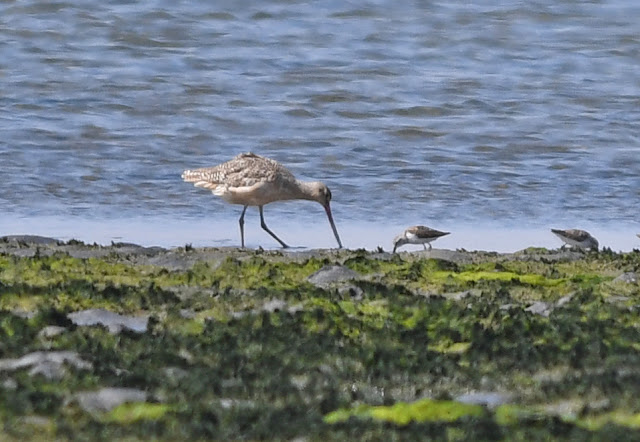 |
| Marbled Godwit - RN de Paracas, Ica, Peru |
August 13, 2022
Originally, I had hoped to spend the previous afternoon/evening and this morning viewing the abundant birds congregating on the mudflats. Following the disaster of the previous day this option was off the table. Laura and I decided that we would do one of the boat trips to the seabird colony after all, since we had no better options.
 |
| RN Islas Ballestas, Paracas, Ica, Peru |
Back in mid-July, Laura and I had spent a night in Pucusana and had hired a local fisherman to take us out on his boat to view some of the seabirds nesting here. We had a blast, finding everything we hoped for including several Humboldt Penguins. We knew that the Paracas boat trip wouldn’t be anything like this as we would be sharing a boat with up to 40 people, so we kept our expectations low.
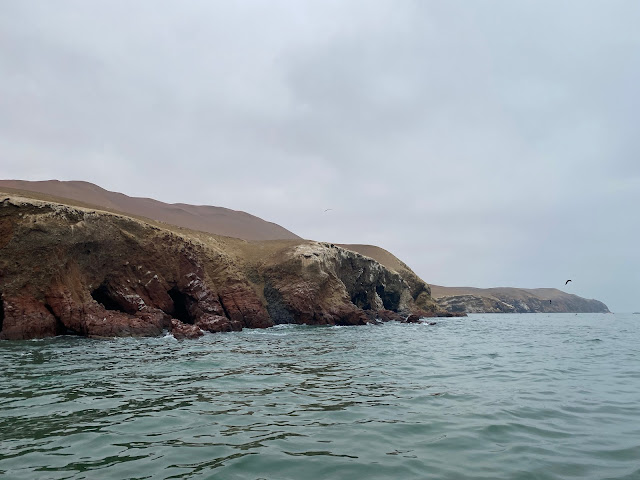 |
| RN de Paracas, Ica, Peru |
Unfortunately, our expectations should have been recalibrated even lower. Despite being promised a 2.5 hour tour of the islands (which included the ~30 minutes each way it took to reach them), our actual tour clocked in at hour and twenty minutes. We sped along in the boat, stopping ever so briefly at a few select sites, before speeding off a minute or two later to the next location. While in the end we saw all of the expected seabirds, it was far from an enjoyable experience. I think our captain was late for something.
 |
| Peruvian Pelican - RN Islas Ballestas, Paracas, Ica, Peru |
That being said, the islands were spectacular. Thousands of Guanay Cormorants and Peruvian Boobies occupied every square inch of them. Where they could, Inca Terns, Peruvian Pelicans and Red-legged Cormorants found roosting sites.
 |
| Guanay Cormorant colony - RN Islas Ballestas, Paracas, Ica, Peru |
 |
| Red-legged Cormorants - RN Islas Ballestas, Paracas, Ica, Peru |
 |
| Inca Terns - RN Islas Ballestas, Paracas, Ica, Peru |
We found several small groups of penguins as well, and I managed a few photos that I was happy with in the 46 seconds that we were allotted to view them.
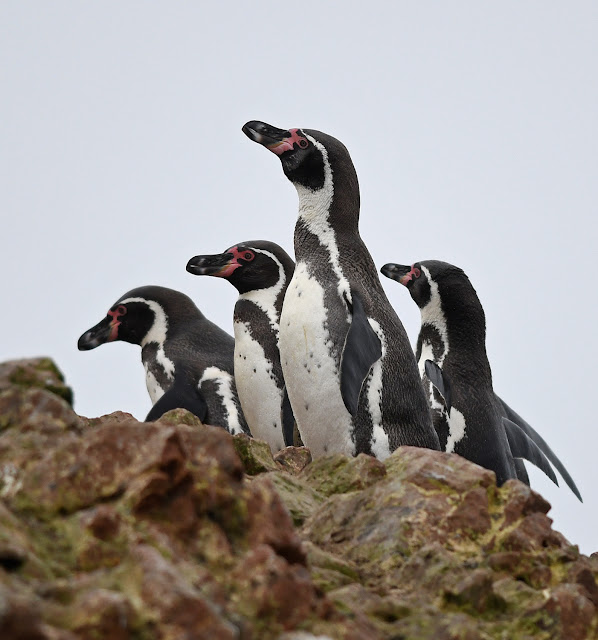 |
| Humboldt Penguins - RN Islas Ballestas, Paracas, Ica, Peru |
 |
| Humboldt Penguin - RN Islas Ballestas, Paracas, Ica, Peru |
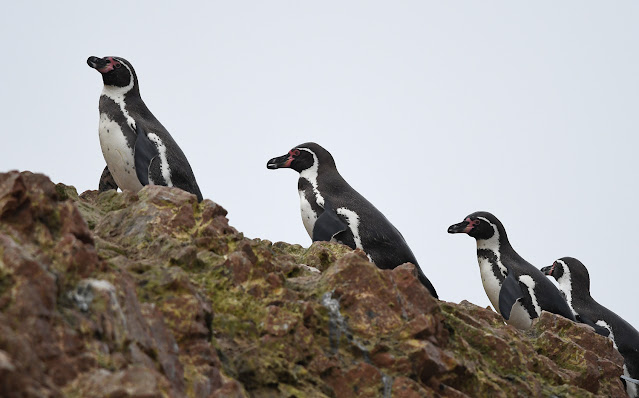 |
| Humboldt Penguins - RN Islas Ballestas, Paracas, Ica, Peru |
 |
| Humboldt Penguin - RN Islas Ballestas, Paracas, Ica, Peru |
Shorebirds were relatively scarce but included both species of oystercatchers and several Ruddy Turnstones.
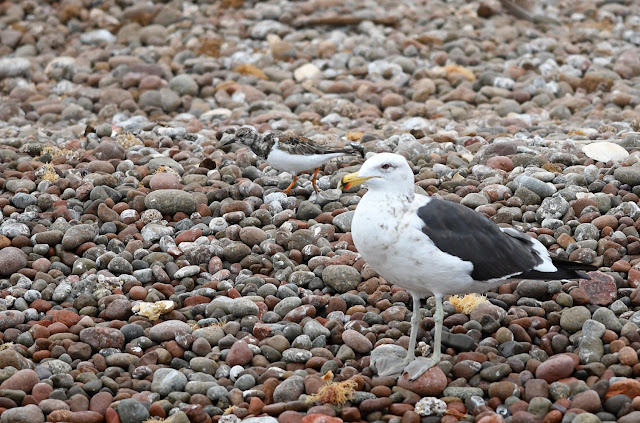 |
| Ruddy Turnstone (and Kelp Gull) - RN Islas Ballestas, Paracas, Ica, Peru |
I held out hope for other seabirds during the open-water crossings. While this was by no means a pelagic trip that reached deep water, several interesting species had been reported from this crossing in the past. Unfortunately, I was unable to spot any storm-petrels or rare terns. The best I could come up with was a single Sooty Shearwater.
 |
| RN Islas Ballestas, Paracas, Ica, Peru |
We made one final stop before arriving back at the dock. Here, several massive male South American Sea Lions lounged on an old rusted boat.
 |
| South American Sea Lion - Paracas, Ica, Peru |
Because our boat trip had ended almost as soon as it had begun, Laura and I still had most of the day ahead of us before our late afternoon bus was scheduled to depart. I really wanted to travel a little further into the Paracas reserve to search for Peruvian Terns. We hummed and hawed over what we should do. Rent bicycles? Hire a taxi for the day? In the end, we decided to rent a scooter as it would give us the freedom to travel wherever we wanted.
 |
| RN de Paracas, Ica, Peru |
The beach I wanted to visit was located in the reserve but off of the standard tourist route, and when we picked up the scooter from the shop we were informed that this area was off-limits. Well, technically we could still drive there, but should we have any mechanical troubles or run out of gas, they would not be able to assist us, since we would be off of the designated tourist route.
This did not faze us, and off we went. With the wind in our hair, we raced off to the desired beach. It was lovely – for the first time, we had escaped the crowds of tourists. It was just us and the birds.
 |
| RN de Paracas, Ica, Peru |
I was surprised at just how many Arctic-breeding shorebirds were present in the Paracas area, given that I had assumed that most of these should still be on the breeding grounds. Perhaps a cohort do not migrate north to breed each year? It may also be a testament to how efficient shorebirds can be at migrating. For species that leave the Arctic in late July or early August, they had already arrived in Peru by mid-August.
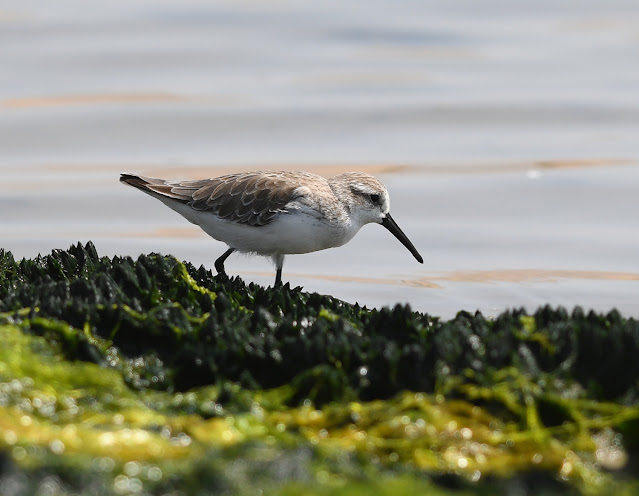 |
| Western Sandpiper - RN de Paracas, Ica, Peru |
Several Western Sandpipers were joined by a single Semipalmated Sandpiper while feeding along the shore. With some effort, I managed a few photos of the two species side-by-side. Back home, Semipalmated Sandpipers are the default species while Westerns are a rare (but regular) migrant, one that we are always on the lookout for. The differences in structure, posture and bill shape are evident in this photo.
 |
| Semipalmated (left) and Western Sandpipers - RN de Paracas, Ica, Peru |
A Belcher’s Gull was having a go at a dead crab along the shoreline.
 |
| Belcher's Gull - RN de Paracas, Ica, Peru |
 |
| Belcher's Gull - RN de Paracas, Ica, Peru |
Snowy Plover is a species that I do not get to see very often, so it was a treat to study a pair of them at close range. They were calling frequently to each other and I managed some good recordings as well.
 |
| Snowy Plover - RN de Paracas, Ica, Peru |
Some scurrying in the sand alerted me to this lizard. I haven’t figured out exactly which species it is, but it is in the genus Microlophus.
 |
| Microlophus sp. - RN de Paracas, Ica, Peru |
Laura and I had walked the length of the bay but were still without our main target, the Peruvian Tern. This tiny species nests inland from the Pacific in barren deserts, though it can sometimes be found in large congregations during the non-breeding season. I had picked this particular bay since it seemed to be a reliable location for Peruvian Terns. But, where were they?
Finally, we picked up two tiny white larids gracefully flying over the bay. Eventually, they landed on some of the dried mud at the edge of the water, almost disappearing from sight. Elated, we walked closer to appreciate them.
 |
| RN de Paracas, Ica, Peru |
With a bit of patience, I approached the terns close enough for some excellent photo opportunities. They were not concerned at all with my presence.
 |
| Peruvian Tern - RN de Paracas, Ica, Peru |
 |
| Peruvian Tern - RN de Paracas, Ica, Peru |
These terns were absolutely miniscule, no bigger than a Sanderling. I love their itty bitty legs!
 |
| Peruvian Tern - RN de Paracas, Ica, Peru |
With still a few hours to go, Laura and I hopped back on the scooter and returned to the designated tourist route. We explored several other beaches and headlands on the peninsula and marveled at how barren it was. Hardly a plant could be seen anywhere! The only signs of life were along the coastline.
 |
| RN de Paracas, Ica, Peru |
We made one final stop before returning the scooter. The sun had fallen far enough in the sky that the heat haze was less of an issue, so we returned to the only trail where one could legally observe the shorebirds at La Aguada. This time, I dutifully stayed on the marked path. In the distance we found a handful of interesting species including Wilson’s Phalaropes, the Marbled Godwits, and a little flock of Red Knots. And with that, we returned the scooter and headed to the bus station. Arequipa awaited!

No comments:
Post a Comment